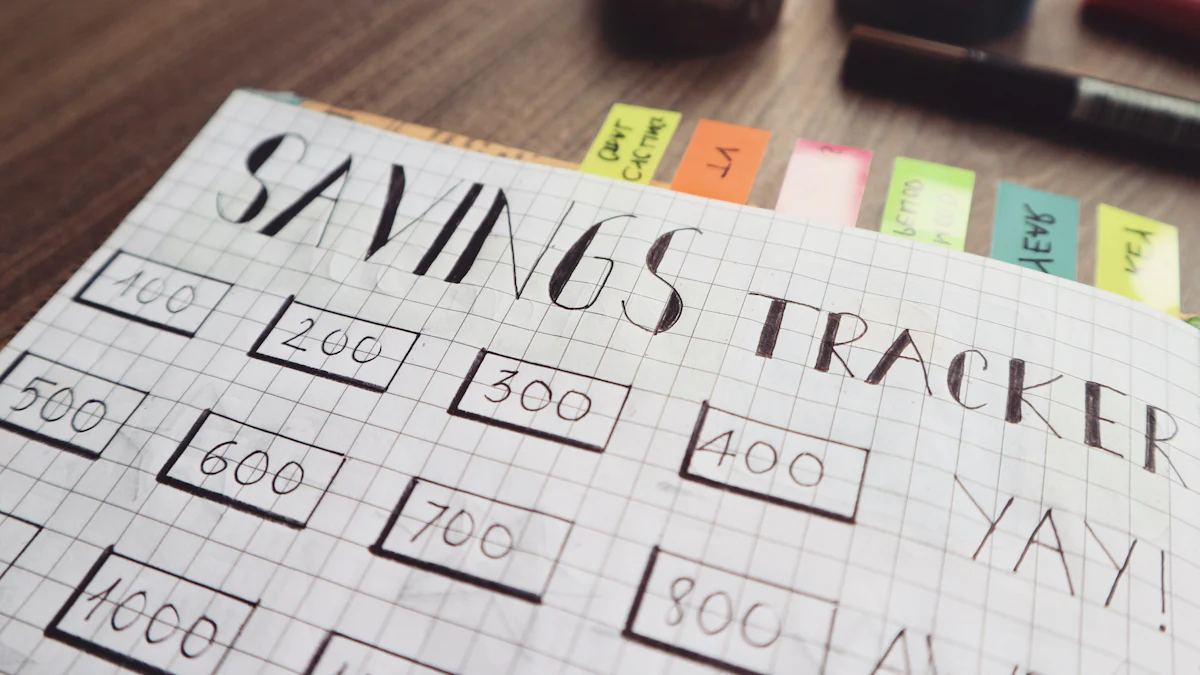Smart Tips for Saving on Everyday Expenses

Saving money doesn’t have to feel overwhelming. With a few smart tips, you can make a big difference in how you manage your daily living expenses. Start by looking at where your money goes every day. Small changes, like cutting unnecessary costs or finding better deals, can lead to significant savings over time. Think about how much you could save by being more intentional with your spending. These money-saving tips aren’t just about cutting back—they’re about making smarter choices that help you take control of your expenses and feel more confident about your finances.
Key Takeaways
Keep track of your spending to see where money goes. Use apps to sort expenses and find ways to save.
Make realistic money goals to help you save. Start small and celebrate wins to stay encouraged.
Set up automatic savings to make it simple. Use apps that save for you to stay consistent.
Use coupons, discounts, and rewards programs when shopping. These can help lower your daily costs a lot.
Plan meals and skip impulse buying to save on food. Write a shopping list and follow it to budget better.
Smart Tips for Budgeting
Track and Categorize Spending
If you want to take control of your money, start by tracking where it goes. Knowing how much you spend on rent, groceries, or entertainment helps you see the bigger picture. Break your expenses into categories like fixed costs (rent, utilities), variable costs (groceries, gas), and discretionary spending (dining out, hobbies). This simple step can reveal areas where you might be overspending.
To make this process easier, try using tools or apps designed for tracking expenses. Here are some great options:
Everydollar: Perfect for zero-based budgeting with drag-and-drop features.
Simplifi: Offers tags for expense tracking and a feature-rich experience.
SupportPay: Ideal for parents sharing expenses with automated records.
Your Banking App: Free and integrates directly with your bank account.
These tools help you categorize spending and identify unnecessary costs. Once you see where your money goes, you can make smarter choices to reduce everyday expenses.
Set Realistic Financial Goals
Setting financial goals gives you a clear direction for your money. Start small and focus on what’s achievable. For example, you could aim to create a budget, pay off credit card debt, or save for an emergency fund. Here’s a quick guide to some common goals:
Goal | Description |
|---|---|
Make a budget | List your income and expenses to create a realistic financial plan. |
Pay off credit card debt | Reduce high-interest debt to improve financial health. |
Start an emergency fund | Save enough to cover three months of living expenses for unexpected events. |
Save for retirement | Set aside money monthly to ensure financial security in later years. |
Choose goals that match your income and lifestyle. Achieving even small goals can motivate you to aim higher.
Automate Savings for Consistency
Saving money doesn’t have to be hard. Automate your savings to make it effortless. Apps like Oportun and Qapital can help. Oportun tracks your spending patterns and moves small amounts into savings. Qapital uses rules like rounding up purchases to grow your savings without you noticing.
Automating savings is especially helpful if you struggle to save on your own. It ensures consistency and builds good habits over time. Whether you’re saving for retirement or a rainy day, automation keeps you on track. Plus, it’s a great way to avoid the temptation of spending extra cash.
By following these tips, you can create a budget, set meaningful goals, and automate your savings to take control of your finances.
Smart Ways to Save Money While Shopping

Use Coupons, Discounts, and Loyalty Programs
If you want to shop smart, start by taking advantage of coupons, discounts, and loyalty programs. These tools can help you save money on everyday purchases. Many stores offer loyalty cards that reward you with points or cash back for frequent shopping. You can also use apps to find deals and significant discounts on items you already plan to buy.
Here’s a quick comparison of some popular coupon platforms:
Platform | Features | App Store Rating | Google Play Rating |
|---|---|---|---|
Flipp | Helps find savings and deals on local products. | 4.8 (423.5K) | 4.7 (346K) |
Capital One Shopping | Automatic coupons, rewards, price drop alerts, Amazon price comparisons. | 4.9 (663.9K) | 4.8 (48.3K) |
Krazy Coupon Lady | Finds specific items on sale from various stores. | 4.9 (147.2K) | 4.8 (56.7K) |
SimplyCodes | Offers automatic coupons and shopping rewards at over 400,000 stores. | 4.2 (11) | 4.3 (36) |
Using these platforms can make it easier to find deals and stretch your budget further.
Buy in Bulk and Shop Off-Season
Buying in bulk is one of the smartest ways to save money, especially for non-perishable items like paper towels, canned goods, or cleaning supplies. Bulk purchases often come with lower per-unit costs, which means you pay less overall. However, be cautious. If you buy items you don’t use before they expire, you could waste money instead of saving it. Bulk shopping works best for larger households or items you use frequently.
Shopping off-season is another great way to score significant discounts. For example:
Winter clothing like coats and boots is cheaper in spring.
Summer gear, such as swimsuits and outdoor furniture, costs less in fall.
Holiday decorations and wrapping paper are heavily discounted after the holidays.
Home goods like furniture and appliances are often on sale during clearance events.
By planning ahead, you can avoid paying full price for seasonal items.
Opt for Generic Brands Over Name Brands
Switching to generic brands is a simple way to save money without sacrificing quality. Many generic products, like sugar, flour, and milk, are made by the same manufacturers as name-brand items. In fact, taste tests show that people often can’t tell the difference between the two.
Here’s how much you can save by choosing generics:
Generic foods typically cost 25% to 30% less than name-brand products.
Store-brand groceries can save you up to 40%.
These savings add up quickly, especially when you’re buying multiple items. So, the next time you shop, consider reaching for the generic option. It’s an easy way to cut costs without compromising on quality.
Save Money on Food and Groceries

Plan Meals and Avoid Impulse Buys
Meal planning is one of the easiest ways to save money on groceries and reduce everyday expenses. By planning your meals for the week, you can avoid last-minute takeout or overspending at the store. A family of five, for example, saved about $500 a month by meal planning. They used it to manage their busy schedules and cut down on eating out. You can do the same by setting aside time each week to decide what you’ll cook and creating a shopping list based on those meals.
Impulse buys can quickly derail your grocery budget. To avoid them, try these tips:
Create a shopping list and stick to it.
Bring only the cash you need to the store.
Wait 24 hours before buying something to see if it’s necessary.
Avoid shopping when you’re emotional or hungry.
Keep your financial goals in mind to resist temptation.
These small changes can help you stay focused and make smarter choices while shopping.
Reduce Food Waste with Creative Leftovers
Reducing food waste is another great way to save money. Instead of tossing leftovers, get creative and turn them into new meals. For example, you can regrow lettuce from the hearts or green onions from the roots. Use carrot tops or radishes to make a waste-free pesto. Leftover jam? Mix it with oil and vinegar to create a delicious salad dressing.
You can also repurpose leftovers into dishes like fried rice, quinoa, or couscous. Soups and stews are perfect for combining leftover veggies and proteins. These ideas not only save money but also add variety to your meals.
Compare Prices and Stick to a List
Comparing prices is a simple yet effective way to maximize your savings. Before heading to the store, check weekly ads or use apps to find the best deals on groceries. Once you’re there, stick to your list to avoid unnecessary purchases. Opt for stores that offer price matching to ensure you’re getting the best value.
By planning meals, avoiding impulse buys, and reducing food waste, you can save money and make your grocery shopping more efficient. These tips will help you take control of your food-related expenses and free up extra cash for other priorities.
Reduce Everyday Expenses on Utilities
Lower Energy Usage with Simple Adjustments
Cutting down on energy use doesn’t have to be complicated. Small changes can lead to big savings on your electric bill. Start by switching to LED bulbs. They use up to 85% less energy than traditional incandescent bulbs and can save you over $100 during their lifetime. Next, optimize how you use appliances. Run your dishwasher only when it’s full, wash clothes in cold water, and set your refrigerator to the recommended temperature (around 37°F for the fridge and 0°F for the freezer).
Don’t forget to seal air leaks around windows and doors. These leaks can waste as much energy as leaving a 3-foot by 3-foot hole in your wall. By sealing them, you’ll keep your home comfortable and reduce energy loss. These simple adjustments can make a noticeable difference in your monthly bills and help you save money over time.
Save on Water Bills with Efficient Practices
Water-saving habits can lower your bills and conserve resources. Wash only full loads of laundry or adjust the water level for smaller loads. Use cold water instead of hot—it’s better for your wallet and the environment. When brushing your teeth or shaving, turn off the tap to avoid wasting water.
If you have a yard, consider creating a water-smart landscape. Choose plants that require less water and use mulch to retain soil moisture. For outdoor cleaning, sweep driveways and sidewalks instead of hosing them down. If you own a pool, cover it when not in use to reduce evaporation. These practices are easy to adopt and can lead to significant savings on your water bill.
Optimize Heating and Cooling Costs
Heating and cooling costs can take a big chunk out of your budget, but you can reduce them without sacrificing comfort. Install a programmable thermostat to adjust temperatures based on your schedule. For example, lower the heat when you’re asleep or away from home. Use ceiling fans to circulate air and create a wind-chill effect, making rooms feel cooler without cranking up the AC.
Seal air leaks and add insulation to maintain a consistent indoor temperature. During hot months, close curtains or use shading techniques to block out the sun. At night, open windows and use fans to bring in cooler air. Regular HVAC maintenance also ensures your system runs efficiently. These steps not only improve comfort but also boost your savings.
By making these adjustments, you can lower your utility bills and free up extra money for other priorities.
Cut Costs on Subscriptions and Transportation
Cancel Unnecessary Subscriptions
Unused subscriptions can quietly drain your wallet every month. It’s easy to forget about them, but they add up fast. On average, people waste $32.84 monthly on subscriptions they don’t use. That’s over $1,294 a year! Start by reviewing your bank or credit card statements to identify recurring charges. You might be surprised to find services you no longer need or use.
Here’s a quick look at some common unused subscriptions:
Subscription | Percentage Unused |
|---|---|
Amazon Prime | 30.1% |
Netflix | 28.2% |
Disney+ | 27.6% |
Amazon Prime Video | 26.0% |
Walmart+ | 26.9% |
Chewy | 22.1% |
Dollar Shave Club | 20.9% |
Shipt | 20.5% |
Canceling these unnecessary subscriptions can free up extra cash for savings or other priorities. Use apps like Truebill or Rocket Money to track and cut unnecessary subscriptions with ease.
Use Public Transportation or Carpool
Driving alone can be expensive. Gas, tolls, parking fees, and maintenance costs add up quickly. Switching to public transportation or carpooling can help you save money while reducing stress. Sharing rides lets you split fuel costs and even use HOV lanes to speed up your commute. Public transportation eliminates parking fees altogether.
Beyond saving money, these options are better for the environment. Fewer cars on the road mean lower carbon emissions. Plus, you’ll contribute to a cleaner, greener planet.
Walk or Bike to Save Money and Stay Active
Walking or biking isn’t just good for your health—it’s great for your wallet too. Biking can save about 50 cents per mile compared to driving. Over time, this can lead to thousands of dollars in savings. If you switch to biking for errands or short commutes, you’ll notice the difference in your budget.
Walking and biking also provide excellent exercise. They improve your physical health and boost your mood. You’ll save money on gym memberships while staying active. It’s a win-win for your finances and well-being.
By canceling unused subscriptions, using public transportation, and walking or biking more often, you can cut costs and save money effortlessly. These tips are simple but effective ways to take control of your expenses.
Saving money doesn’t have to feel like a chore. Start small by making one or two changes from the tips above. Over time, these small steps will add up and make a big difference in your finances. Consistency is key, so stick with it even if progress feels slow at first.
Celebrate your wins, no matter how small they seem. Did you cancel an unused subscription? That’s a win! Found a great deal while shopping? Another win! Recognizing these moments keeps you motivated and reminds you that you’re in control of your money. Stay committed, and you’ll see the rewards of your efforts grow.
See Also
Effective Strategies for Saving Your Hard-Earned Cash
Smart Ways to Cut Your Grocery Expenses
Essential Tips to Secure Your Finances During Recession

